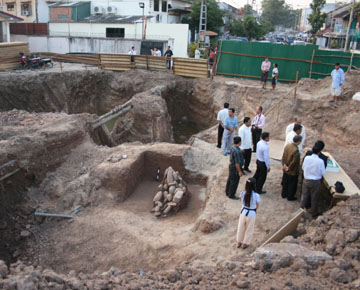
© Unknown
The recent discovery of mysterious stones buried in the construction site of the new City Pillar Hall in Vientiane has given archaeologists new insight into these puzzling objects.
More than 90 stones, which archeologists describe as city pillars, were found in Phiavath village, Sisattanak district, during excavations for the new building.
Experts believe the use of these stone monuments first began in the north of Laos. This latest discovery has inspired them to dig deeper into their history.
Director General of the National Heritage Department of the Ministry of Information, Mr Thongsa Sayavongkhamdy, said they have identified engravings on the stones which they believe will provide valuable information about their origin and purpose.
"It has been most interesting this time to find one pillar shaped like a baisema ," he said.
News of the latest discovery of city pillars amazed people, with many going to see the stones after they were unearthed from a depth of 3 metres.
After more than 190 pillars were dug up on nearby Setthathirath Road on January 17, 2007, archaeologists presume the stones discovered last month are linked and serve the same function.
Mr Thongsa said in 1520 AD Phothisarath came to the throne as king. In 1527, he led his people south to build a new city and temples on the site of the modern city of Vientiane. Archaeologists believe the practice of setting up city pillars began at the same time.
However, their exact origin and purpose is still a mystery and there are still many unanswered questions, even though archaeologists have records of ceremonies being held around pillars in the northern provinces.
Experts cannot say why so many pointed column-like stones were buried deep in the ground or why these pillars were originally set out on the ground. Most of the pillars they have studied in the northern provinces were laid out in a group in village centres.
Australian cultural and conservation expert Ms Marion Ravenscroft, who works at the National Museum in Vientiane, said that at this stage it was not known where the stones came from or why they were buried there.
"The discovery interests me a lot because they are different in terms of shape. I will find more details when the stones are brought over to the museum next week," she said.
She will be working closely with a Japanese expert to try and unravel the story behind the oddly shaped rocks.
According to folklore, people held ceremonies around village or district pillars when setting up new communities. These ceremonies have been observed to this day, especially in the north.
According to the National Heritage Department, a village or district pillar was considered an important symbol of a community's boundaries and marked the people's territorial rights. The pillars served to remind villagers of the shared ownership of their land and rivers.
Whenever food supplies and crop yields were low or a fatal disease broke out, villagers would organise a blessing ritual aimed to restore balance, build confidence and call on the village's guardian spirits to ward off evil.
During these times people added more stones and wood to the village pillar.
"The pillar became an important part of village life, symbolising unity," Mr Thongsa said.
The city pillar rite has long been practised by the Leu, an ethnic group found in the northern provinces.
A pillar is placed at the heart of the village, indicating its importance in the community. Villagers frequently clean the pillar and hold rites to bless their village.
No current research can provide an explanation of the origins of the Vientiane city pillars. But archaeologists believe they indicate the traditional reverence of people for village and district pillars, their importance in society, and how folklore combines with long-standing tradition in ways that are practised to the present time.
As the new discovery occurred near Simeuang temple, where Vientiane's city pillar is situated, there is thought to be a link.
Folklore surrounding the Vientiane city pillar at Vat Simeuang holds that a person had to be buried alive when the pillar was set in the ground, as it was believed this would ensure harmony and abundance.
A pregnant woman named Si sacrificed herself by jumping into the pit that had been dug before the pillar was set in place, to embody Nha Mae Simeuang, the protective spirit of Vientiane.
Since that time the site has been one of the most respected and venerated in the city, with devotees from far and near visiting Vat Simeuang to worship Nha Mae Simeuang.
The story of Nha Mae Simeuang may originate with this rite but none of the research shows where the beliefs associated with the city pillar come from. The newly discovered pillars will be displayed in the City Pillar Hall when it is built.
The hall's design is based on the Buddhist style, and is 29 metres high and 17 metres long. Construction will start next month and is set for completion in 2011. The construction cost is expected to be about 9 billion kip.
Archaeologists believe the latest discovery is a good omen ahead of the start of construction. They also believe they did not discover the pillars by chance.
Reader Comments
to our Newsletter